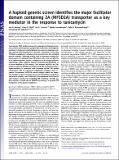| dc.contributor.author | Reiling, Jan H. | |
| dc.contributor.author | Clish, Clary | |
| dc.contributor.author | Carette, Jan E. | |
| dc.contributor.author | Varadarajan, Malini | |
| dc.contributor.author | Brummelkamp, Thijn R. | |
| dc.contributor.author | Sabatini, David | |
| dc.date.accessioned | 2012-02-01T20:47:46Z | |
| dc.date.available | 2012-02-01T20:47:46Z | |
| dc.date.issued | 2011-06 | |
| dc.date.submitted | 2010-12 | |
| dc.identifier.issn | 0027-8424 | |
| dc.identifier.issn | 1091-6490 | |
| dc.identifier.uri | http://hdl.handle.net/1721.1/69001 | |
| dc.description.abstract | Tunicamycin (TM) inhibits eukaryotic asparagine-linked glycosylation, protein palmitoylation, ganglioside production, proteoglycan synthesis, 3-hydroxy-3-methylglutaryl coenzyme-A reductase activity, and cell wall biosynthesis in bacteria. Treatment of cells with TM elicits endoplasmic reticulum stress and activates the unfolded protein response. Although widely used in laboratory settings for many years, it is unknown how TM enters cells. Here, we identify in an unbiased genetic screen a transporter of the major facilitator superfamily, major facilitator domain containing 2A (MFSD2A), as a critical mediator of TM toxicity. Cells without MFSD2A are TM-resistant, whereas MFSD2A-overexpressing cells are hypersensitive. Hypersensitivity is associated with increased cellular TM uptake concomitant with an enhanced endoplasmic reticulum stress response. Furthermore, MFSD2A mutant analysis reveals an important function of the C terminus for correct intracellular localization and protein stability, and it identifies transmembrane helical amino acid residues essential for mediating TM sensitivity. Overall, our data uncover a critical role for MFSD2A by acting as a putative TM transporter at the plasma membrane. | en_US |
| dc.description.sponsorship | Human Frontier Science Program (Strasbourg, France) | en_US |
| dc.description.sponsorship | United States. National Institutes of Health (Grant R21 HG004938-01) | en_US |
| dc.description.sponsorship | United States. National Institutes of Health (Grant CA103866) | en_US |
| dc.description.sponsorship | United States. National Institutes of Health (Grant CA129105) | en_US |
| dc.language.iso | en_US | |
| dc.publisher | Proceedings of the National Academy of Sciences (PNAS) | en_US |
| dc.relation.isversionof | http://dx.doi.org/10.1073/pnas.1018098108 | en_US |
| dc.rights | Article is made available in accordance with the publisher's policy and may be subject to US copyright law. Please refer to the publisher's site for terms of use. | en_US |
| dc.source | PNAS | en_US |
| dc.title | A haploid genetic screen identifies the major facilitator domain containing 2A (MFSD2A) transporter as a key mediator in the response to tunicamycin | en_US |
| dc.type | Article | en_US |
| dc.identifier.citation | Reiling, J. H. et al. “From the Cover: Feature Article: A haploid genetic screen identifies the major facilitator domain containing 2A (MFSD2A) transporter as a key mediator in the response to tunicamycin.” Proceedings of the National Academy of Sciences 108.29 (2011): 11756-11765. Web. 1 Feb. 2012. | en_US |
| dc.contributor.department | Broad Institute of MIT and Harvard | en_US |
| dc.contributor.department | Massachusetts Institute of Technology. Department of Biology | en_US |
| dc.contributor.department | Whitehead Institute for Biomedical Research | en_US |
| dc.contributor.department | Koch Institute for Integrative Cancer Research at MIT | en_US |
| dc.contributor.approver | Sabatini, David | |
| dc.contributor.mitauthor | Reiling, Jan H. | |
| dc.contributor.mitauthor | Clish, Clary | |
| dc.contributor.mitauthor | Carette, Jan E. | |
| dc.contributor.mitauthor | Varadarajan, Malini | |
| dc.contributor.mitauthor | Brummelkamp, Thijn R. | |
| dc.contributor.mitauthor | Sabatini, David M. | |
| dc.relation.journal | Proceedings of the National Academy of Sciences | en_US |
| dc.eprint.version | Final published version | en_US |
| dc.type.uri | http://purl.org/eprint/type/JournalArticle | en_US |
| eprint.status | http://purl.org/eprint/status/PeerReviewed | en_US |
| dspace.orderedauthors | Reiling, J. H.; Clish, C. B.; Carette, J. E.; Varadarajan, M.; Brummelkamp, T. R.; Sabatini, D. M. | en |
| dc.identifier.orcid | https://orcid.org/0000-0002-1446-7256 | |
| mit.license | PUBLISHER_POLICY | en_US |
| mit.metadata.status | Complete | |
